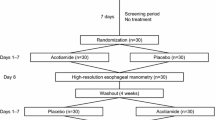Abstract
Controversy exists over whether diazepam can be used for sedation during esophageal manometry studies without affecting the results. To evaluate the effect of diazepam, 20 healthy asymptomatic volunteers were studied using a standard manometry protocol employing an Arndorfer capillary infusion system. Following a baseline manometry, each subject received 0.1 mg/kg diazepam intravenously over 1 min and underwent repeat manometry 5 min after completion of the injection. All manometry recordings were coded and read blindly. The amplitude of the lower esophageal sphincter was significantly reduced by diazepam from 26.2±10.9 and 30.0±10.9 mm Hg to 18.8±7.6 and 24.5±9.7 mm Hg by rapid and station pull-through methods, respectively (P<0.01 all both methods). Esophageal contraction wave duration was significantly increased following diazepam at 3, 8, and 13 cm above the lower esophageal sphincter (P<0.01 all levels). There was a trend toward increased contraction wave amplitude following diazepam administration in the lower three fourths of the esophagus. On the basis of these results, we conclude that diazepam sedation may produce misleading results when used during esophageal manometric testing. It is recommended that diazepam not be used in manometric studies of normal subjects or patients with reflux esophagitis and that manometric findings in patients with hypertensive or spastic disorders be interpreted with caution if diazepam is given as a premedication.
Similar content being viewed by others
References
Russell C, Whelan G: Oesophageal manometry: How well does it predict oesophageal function. Gut 28:940–945, 1987
Hurwitz A, Duranceau A, Haddad J: Disorders of the lower esophageal sphincter.In Disorders of Esophageal Motility. L. Smith (ed). Philadelphia, WB Saunders, 1979, p 120
Hall A, Moossa A, Clark J, Cooley G, Skinner D: The effects of premedication drugs on the lower oesophageal high pressure zone and reflux status of Rhesus monkeys and man. Gut 16:347–352, 1975
Weihrauch T, Forster C, Kohler H, Ewe K, Krieglstein J: Effect of intravenous diazepam on human lower oesophageal sphincter pressure under controlled double blind crossover conditions. Gut 20:64–67, 1979
Hacker J, Cattau E: Effects of nasopharyngeal cocaine or pharyngeal benzocaine on esophageal motility. Am J Gastroenterol 82:127–129, 1987
Nasrallah S, Hendrix E: The effect of topical pharyngeal anesthesia on esophageal motility. Am J Gastroenterol 82:523–525, 1987
Rushnak MJ, Leevy CM: Effect of diazepam on the lower esophageal sphincter. Am J Gastroenterol 73:127–130, 1980
Ishii K, Kano T, Akutagawa M, Makino M, Tanaka T, Ando J: Effects of flurazepam and diazepam in isolated guinea-pig taenia coli. Eur J Pharmacol 83:329–333, 1982
Author information
Authors and Affiliations
Rights and permissions
About this article
Cite this article
Reveille, R.M., Goff, J.S. & Hollstrom-Tarwater, K. The effect of intravenous diazepam on esophageal motility in normal subjects. Digest Dis Sci 36, 1046–1049 (1991). https://doi.org/10.1007/BF01297445
Received:
Revised:
Accepted:
Issue Date:
DOI: https://doi.org/10.1007/BF01297445




